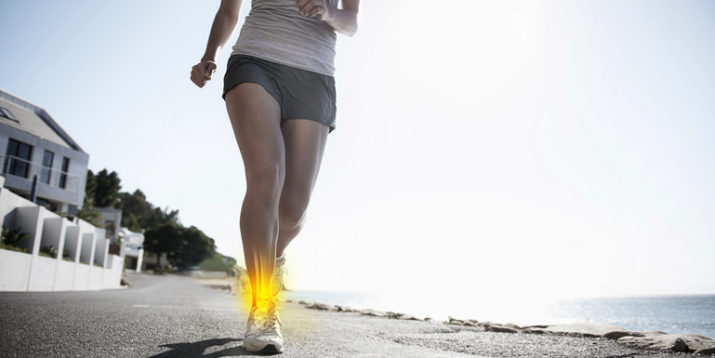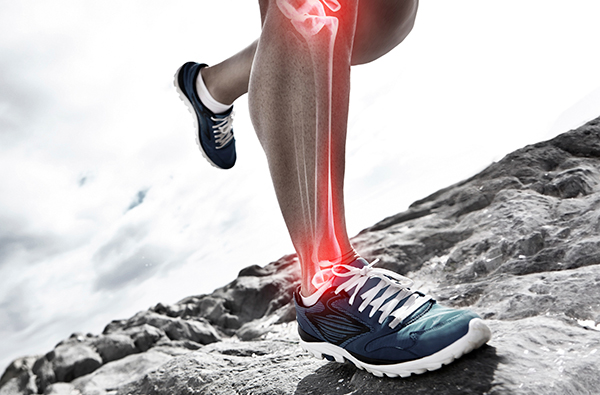6 Ankle Strengthening Exercises to Prevent Injury

Many of us who exercise regularly, perform tough workouts, or play sports tend to worry about knee pain before we ever consider our ankle joints — that is, until we’ve sprained them, fractured an ankle, or experienced issues with our Achilles tendons. But ankle strengthening exercises are crucial for avoiding injury and allowing you to do your workout or play a sport to the best of your ability.
Anatomy of the Ankle
Simply stated, the ankle is where leg meets foot. But the ankle technically qualifies as two joints: the true ankle joint, which is the hinge-like mechanism by which the foot moves up and down, and the subtalar joint, which governs its side-to-side motion.
The true ankle joint is the nexus of three bones: the tibia (shinbone), the fibula (skinnier bone of the lower leg), and the talus (small bone above the heel). Forming the subtalar joint are the talus and the heel bone. It’s all bound together by three major ligaments and six tendons that combine to facilitate motion and stability of the foot.
That motion is powered by three main muscle groups, which are targeted by the exercises below: the calf, the peroneals, and the tibialis muscles.
Calf
Comprised of the diamond-shaped gastrocnemius muscle and the soleus beneath it (collectively known as the triceps surae), the calf muscles contribute most to upward movement of the heel, known as plantar flexion.
Peroneals
Located on the outer edge of the ankle and foot, the peroneal muscles primarily angle your foot outward, or (more technically) moving your sole away from the median plane of your body.
Tibialis muscles
Deep beneath the calf, the posterior tibialis supports the arch of the foot, allowing it to angle inward (inversion), while the anterior tibialis — the muscle along your shinbone — enables upward motion of the foot, or dorsiflexion.
Why Is Ankle Strength Important?
Physical activity — be it low- or high-intensity — places necessary stress on the bones, ligaments, tendons, and surrounding muscles of the ankle. According to the American College of Sports Medicine, ankle sprains account for 40 percent of all athletic injuries. And according to the American Academy of Orthpaedic Surgeons, strengthening the muscles that support the ankle is the best way to prevent them.
If the ankle musculature is strong, the athlete can withstand greater force before an injury is sustained. In addition to decreasing ankle injuries, strengthening lower leg muscles helps prevent chronic conditions such as shin splints and Achilles tendonitis.
The most common causes of ankle injuries involve twisting or rotating your ankle, rolling your ankle, tripping or falling, or a big impact (such as a car accident) damaging the ankle in some way.
6 Ankle Strengthening Exercises to Prevent Injury
To help prevent the bulk of the above injuries, work a couple of the following ankle strengthening exercises into every workout. Studies show you should also be strengthening your glutes, which will help your body control deceleration and decrease the impact on your ankle joints during exercises like plyometrics.
And remember: Among the best things you can do for your ankles is to spend time warming up before a workout. “Warm up properly and stretch thoroughly afterwards. Start with an easy jog, a quick spin on a stationary bike or elliptical, or a brief set of jumping rope,” says Jonathan M. Roth, M.D., an orthopedic surgeon who specializes in sports medicine at Fort Belvoir Community Hospital in Alexandria, VA.
Runner’s Lunge Knee Drive Warrior 3
Appears in: PiYo – Drench
Benefits: The forward and backward movement of this combination exercise can help strengthen the calf and anterior tibialis muscles, while the balance required also recruits the posterior tibialis and peroneals , explains Twin Cities-based personal trainer Holly Janiszewski, NASM-CPT.
- Assume a pushup position: hands aligned with (and slightly wider than) your shoulders, arms straight, feet together, and body straight from head to heels.
- Transition to a low lunge by stepping your right foot to just inside your right hand, so that your right knee is in your armpit. This is your starting position.
- Keeping your back flat and abs engaged, press into your right foot and stand up straight as you lift your left knee to waist level, pumping your arms in sync with the movement of your left leg (left knee up, right arm forward).
- Tap your left toes on the floor, bring your left knee back up to waist level, lower your arms to your sides, and then hinge forward at your waist, straightening your left leg behind you and keeping your back flat as you bring your torso as close to parallel to the floor as possible.
- Hold for one second, then slowly bend your right knee and lower yourself back to the starting position.
- Switch legs and repeat, continuing to alternate sides for a total of 10 reps.
Single-Leg Deadlift Squat
Appears in: P90X – Legs and Back
Benefits: Poor proprioception — your body’s sense of its own position and alignment — is one of the primary culprits in ankle instability and injury… which can cause even poorer proprioception. “Balance exercises like this one are important for ankle strength because they challenge and improve that proprioceptive sense,” says Janiszewski.
- Stand tall with your feet together and raise your right foot a few inches off the floor behind you. This is your starting position.
- Keeping your back flat, core braced, and rear foot elevated, push your hips back and bend your left knee as you reach down and touch the floor with both hands (or as close as you can get without your chest dropping below your waist).
- Do equal reps on both legs.
Trainer tip: “Keep your weight on your planted heel, and never let the knee of that leg track in front of your toes,” says Janiszewski.
Air Jack
Appears in: TurboFire – HIIT 15
Benefits: This unique twist on a classic exercise trains your body to better absorb the impact force of landing, reducing the risk of injury to your ankles, says Janiszewski.
- Stand tall with your feet together and your arms at your sides.
- Dip your knees, and then jump up, simultaneously raising your arms and legs out to your sides (your body should form an “X” in mid-air).
- Land softly with your feet together and arms at your sides, and immediately dip your knees in preparation for the next jump.
Plank to Chaturanga Run
Appears in: P90X – Core Synergistics
Benefits: Another yoga-inspired move, this dynamic drill contributes to both ankle mobility and stability. It also cultivates proprioception, wherein signals from the muscles, joints, and tendons work in tandem to offer your brain data on where your limbs are in space. A proprioceptive deficiency might, for instance, make you more likely to land on the outside of your foot while running, causing you to roll your ankle, explained Janiszewski.
- Start in a push-up position with your body and arms straight, and your hands aligned with (but slightly wider than) your shoulders.
- Keeping your back flat and your arms straight, bring your right knee as close to your chest as possible, tapping the floor with your toes.
- As you return your right foot to the starting position, bring your left knee as close to your chest as possible, tapping the floor with your toes. (This movement is the plank run.)
- Continue alternating for 10 seconds, and then lower your chest to within a few inches of the floor, alternately bringing your right knee to your right elbow and your left knee to your left elbow. (This movement is the chaturanga run.)
- Continue alternating for 10 seconds to complete one “set.”
Trainer tip: “Focus on keeping your core tight throughout the entire exercise,” says Janiszewski.
The Heisman
Appears in: Insanity – Max Cardio Conditioning
Benefits: Incorporating lateral moves like this one into your training program is important for strengthening your peroneal muscles, especially if your workouts typically consist of forward-motion exercises.
- Assume a defensive stance with your legs shoulder-width apart, knees bent, chest held high, arms up, and your gaze straight ahead.
- Push off your left foot and hop to your right, bringing your left knee above waist level as you pump your right arm forward and land on your right foot.
- Now hop to your left, reversing your arm and leg movements.
- Continue alternating sides.
Trainer tip: “Plant your foot flat on the ground and draw your knee up using your abs (as opposed to your hip flexors). Beginners should start slower with this movement and gradually work towards getting faster,” says Janiszewski.
Calf Raise
Appears in: P90X – Legs and Back
Benefits: Since ankle strength depends on strengthening the surrounding muscles, ligaments, and tendons, this move—which does just that—can go a long way toward fortifying the entire lower leg. And because it’s a unilateral (single limb) exercise, it also challenges your stability, helping you improve it, says Janiszewski.
- Stand with your feet should-width apart and your toes pointing slightly outward, holding a pair of dumbbells at arm’s length by your sides.
- Keeping your back straight and core braced, rise up onto the balls of your feet. Pause, and then return to the starting position.
Trainer tip: Do 15 slow controlled reps followed by 10 quick ones, and then repeat the entire sequence with your feet parallel.
Plyometrics and sports
“Jumping rope is a great way to teach soft landings,” says Roth. You can also increase the cadence as you get comfortable building speed. For lateral training — or side-to-side ankle stability — both tennis and basketball are sports that work your ankles and lower leg muscles.
In The Master’s Hammer and Chisel, trainers Autumn Calabrese and Sagi Kalev offer several effective ankle strengthening exercises to help prevent injury and fortify the ankles and feet:
- Rotating squat jumps
- Multidirectional lunges
- Skater triangles
- Side shuffles
- Lateral squat hop
Ankle Stretches to Prevent Injury
Roth suggests stretching your feet and ankles thoroughly after each workout to further stabilize and support your lower leg. Here are two effective, common ankle stretches:
Step calf stretch
Calf stretching is important to maintain flexibility while strengthening and preventing injury to the lower legs and ankles.
- Stand tall on a step with the middle of your feet on the edge (hold onto a table or railing if you need more balance).
- Lower your heels to feel the stretch in your calves. Hold for several seconds, and then rise up onto the balls of your feet.
- Return to the starting position and repeat.
Yoga downward dog
- Get down on all fours, knees directly below hips, hands shoulder-width apart, and wrists a couple inches forward of your shoulders.
- With your fingertips pointed forward and spread apart, tuck your toes and lift your hips to the ceiling. Avoid shrugging your shoulders toward your ears by rotating your shoulders outward.
- Straighten your arms, (avoid locking your elbows), and engage the core muscles toward the spine to slightly tuck the tailbone and elongate the lower back.
- Press your heels down toward the floor and attempt to straighten your legs without locking your knees.
Preventing these kinds of sports injuries will ensure the longevity of your muscles and joints. It’s never too late to start working ankle strengthening exercises into your regimen.

